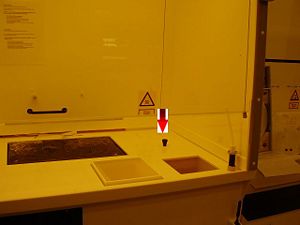Specific Process Knowledge/Etch/Etching of Titanium: Difference between revisions
| Line 39: | Line 39: | ||
!Etch rate range | !Etch rate range | ||
| | | | ||
*~ | *~?nm/min | ||
| | | | ||
*~?nm/min | *~?nm/min | ||
Revision as of 16:03, 12 March 2013
THIS PAGE IS UNDER CONSTRUCTION
Feedback to this page: click here
Etching of Titanium
Etching of titanium can be done either by wet etch, dry etch or by sputtering with ions.
Comparison of Titanium Etch Metodes
| Ti wet etch 1 | Ti wet etch 2 | ICP metal | IBE (Ionfab300+) | |
|---|---|---|---|---|
| Generel description | BHF:Etch of titanium with or without photoresist mask. | Cold RCA1: Etch of titanium (as stripper or with eagle resist). | Dry plasma etch of Ti | Sputtering of Ti - pure physical etch |
| Etch rate range |
|
|
|
|
| Etch profile |
|
|
|
|
| Substrate size |
|
|
|
Smaller pieces glued to carrier wafer
|
| Allowed materials |
No restrictions cross contamination wise as long as you use the right beaker and make sure that they are safe to enter in the chemicals |
No restrictions cross contamination wise as long as you use the right beaker and make sure that they are safe to enter in the chemicals |
|
|
Ething of Titanium can be done either wet or dry. For wet etching please see below on this page. Dry etching can be done either with ICP using Chlorine chemistry or with IBE by sputtering with Ar ions.
Wet etching of Titanium
We have two solutions for wet titanium etching:
- BHF
- Cold RCA1
Do it by making your own set up in a beaker in a fume hood - preferably in cleanroom 2 or 4. BHF etching can also take place in the PP-etch bath in the fume hood in cleanroom 2.
Comparing the two solutions
| BHF | Cold RCA1 | |
|---|---|---|
| General description | Etch of titanium with or without photoresist mask. | Etch of titanium (as stripper or with eagle resist). |
| Chemical solution | HF:NH4F | NH3OH:H2O2:H2O - 1:1:5 |
| Process temperature | Room temperature | Room temperature |
| Possible masking materials |
Photoresist (1.5 µm AZ5214E) |
Eagle resist |
| Etch rate |
Not known (it bubbles while etching) |
Not known |
| Batch size |
1-5 4" in beaker 1-25 wafers at a time in PP-etch bath |
1-5 4" wafer at a time |
| Etch bath | Beaker or PP-etch bath in the fume hood in cleanroom 2. | Beaker |
| Allowed materials |
No restrictions when used in beaker or PP-etch bath in the fume hood in cleanroom 2. Make a note on the beaker of which materials have been processed. |
No restrictions when used in beaker. Make a note on the beaker of which materials have been processed. |
Dry etching of titanium
See the ICP Metal Etch page.
